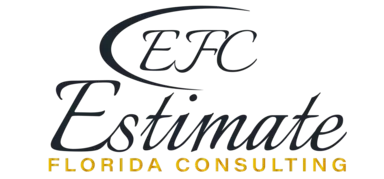- Homepage
- Construction in Coral Gables
Multi-Family Building Construction in Coral Gables
Leading provider of multi-family building construction services.
Constructing a multi-family building in Coral Gables is a strategic venture that meets the city’s surging housing demand while navigating its coastal challenges, vibrant urban growth, and premium real estate landscape. From low-rise apartment complexes to high-rise residential towers, costs reflect Coral Gables’s high land prices, hurricane resilience needs, and desire for modern, amenity-rich living spaces. At Estimate Florida Consulting, we offer precise, customized estimates to ensure your multi-family project succeeds in this dynamic market. In this guide, we’ll explore multi-family building construction costs in Coral Gables, featuring detailed tables, an in-depth breakdown with construction specifics, and answers to common questions—equipping you to deliver housing that endures.
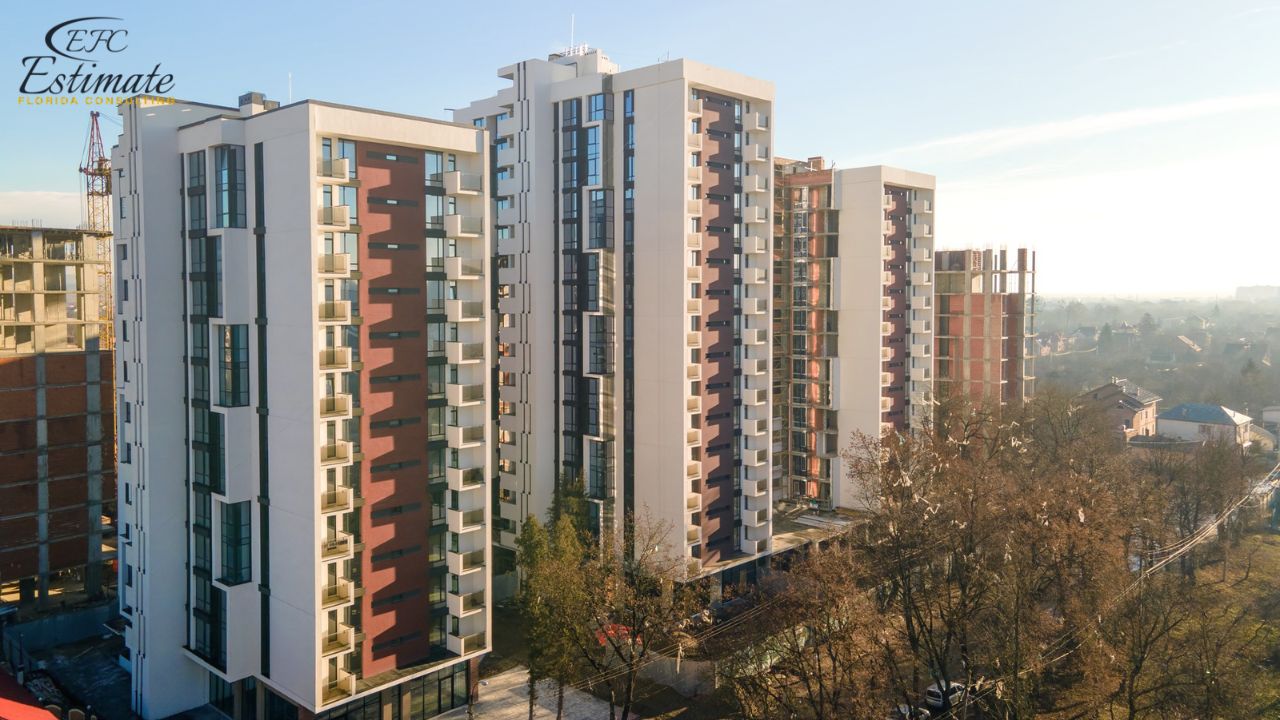
What Drives Multi-Family Building Construction Costs in Coral Gables?
Coral Gables’s construction landscape is influenced by several high-cost factors. Land in prime locations like Mizner Park or near Florida Atlantic University ranges from $100 – $250 per square foot due to high demand and limited availability, while more suburban areas like West Boca offer slightly lower prices at $50 – $150 per sq ft. The city’s coastal location requires hurricane-resistant construction, including reinforced concrete, impact-resistant glass, and elevated foundations, which significantly increase material and labor expenses. Skilled labor shortages push wages to $35 – $50/hour for specialized trades such as electricians, masons, and HVAC technicians.
Additionally, Coral Gables’s upscale market drives the need for premium multi-family features, such as resort-style pools, fitness centers, co-working spaces, and smart home technology. Developers must comply with Palm Beach County’s strict zoning and building regulations, further adding to project costs. Demand for luxury multi-family developments continues to rise, compelling builders to invest in high-end finishes and sustainable construction practices to remain competitive. Overall, multi-family construction costs in Coral Gables typically range from $250 to $500 per square foot, depending on location, design complexity, and amenities.
Multi-Family Construction Cost per Square Foot in Coral Gables
Understanding the cost per square foot is key to budgeting a multi-family project in Coral Gables. Prices vary based on building scale, location, and features, ranging from $200 for simpler, suburban complexes to $450 for luxury high-rises in urban cores like Brickell. These figures account for Coral Gables’s premium materials, labor rates, and hurricane-proofing requirements, excluding land costs which can significantly alter the overall investment. Below is a quick breakdown:
Building Type | Cost Per Sq Ft | Key Cost Drivers |
Small Apartment Complex | $200 – $250 | Basic materials, minimal amenities |
Mid-Rise Apartment Building | $250 – $300 | Mid-tier finishes, added facilities |
Large Residential Complex | $300 – $400 | Elevators, parking, upscale features |
High-Rise Residential Tower | $350 – $450 | Luxury finishes, extensive systems |
Multi-Family Building Cost Construction in Coral Gables
Here’s a detailed table reflecting Coral Gables’s premium multi-family construction market:
Building Type | Size (Square Feet) | Cost Range (Total) | Cost Per Sq Ft | Construction Timeline |
Small Apartment Complex | 10,000 – 30,000 | $2M – $7.5M | $200 – $250 | 10-16 months |
Mid-Rise Apartment Building | 40,000 – 80,000 | $10M – $20M | $250 – $300 | 16-24 months |
Large Residential Complex | 100,000 – 150,000 | $30M – $60M | $300 – $400 | 24-36 months |
High-Rise Residential Tower | 200,000 – 300,000 | $60M – $135M | $350 – $450 | 36-60+ months |
Note: Costs include construction, infrastructure, and basic amenities but exclude land acquisition. For a custom estimate, call 561-530-2845.
90% More Chances to Win Projects With Our Estimate!
- Multi-Family Building
- Hotel Building
- Hospital Building
- Warehouse Building
- School & University Building
- High-Rise Building
- Shopping Complex
- Data Center Building
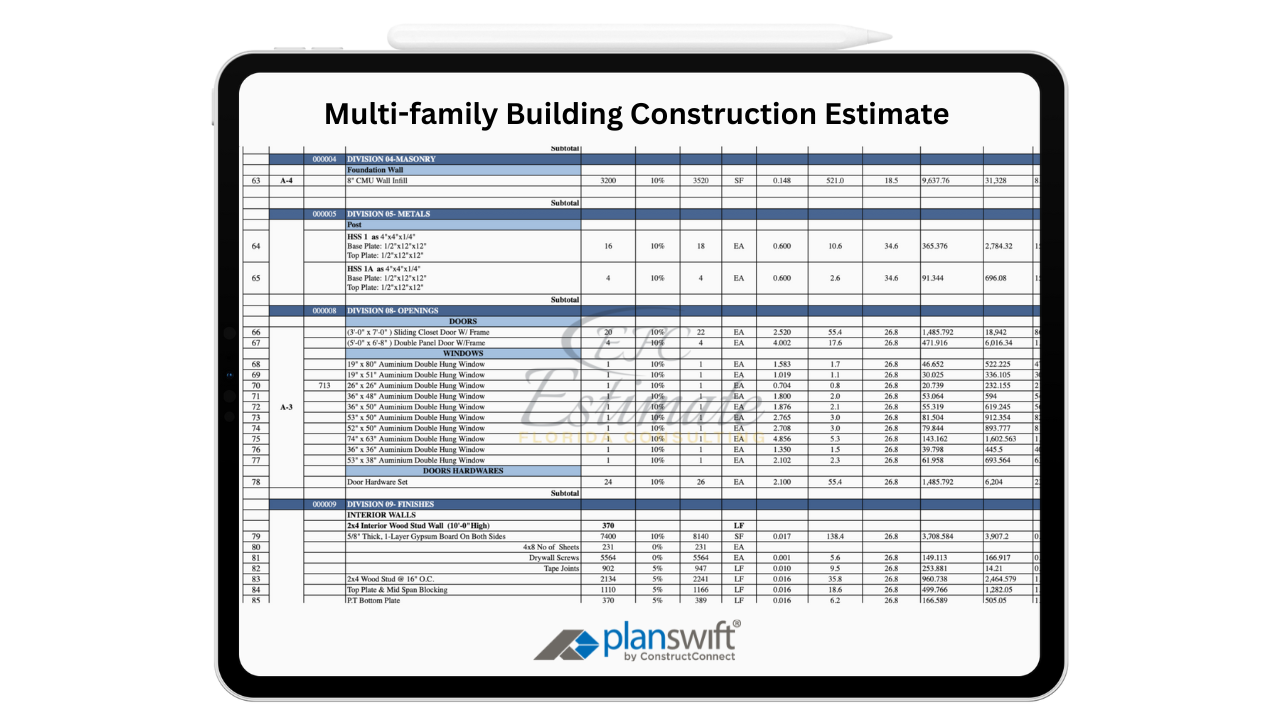
Multi-Family Building Construction Detailed Breakdown in Coral Gables
Multi-family buildings in Coral Gables range from small complexes for local renters to high-rise towers for luxury buyers. Below is a detailed breakdown of construction phases, costs, and multi-family-specific elements across sizes (10,000 to 300,000 square feet) in Coral Gables’s high-demand market.
Size & Scope
- Square Footage: Small complexes span 10,000-30,000 sq ft with 10-25 units (800-1,200 sq ft each), while high-rises reach 200,000-300,000 sq ft with 150-300 units, from studios to three-bedrooms, fitting Coral Gables’s diverse market.
- Total Cost Range: Small complexes cost $2M-$7.5M with basic features, mid-rises $10M-$20M with pools, and high-rises $60M-$135M with luxury finishes and amenities, reflecting Coral Gables’s premium rates.
- Examples: A 20,000 sq ft complex with 15 units, courtyard, and parking; a 60,000 sq ft mid-rise with 50 units, pool, and gym; a 120,000 sq ft complex with 100 units, retail, and dog park; or a 250,000 sq ft tower with 200 units, rooftop, and valet.
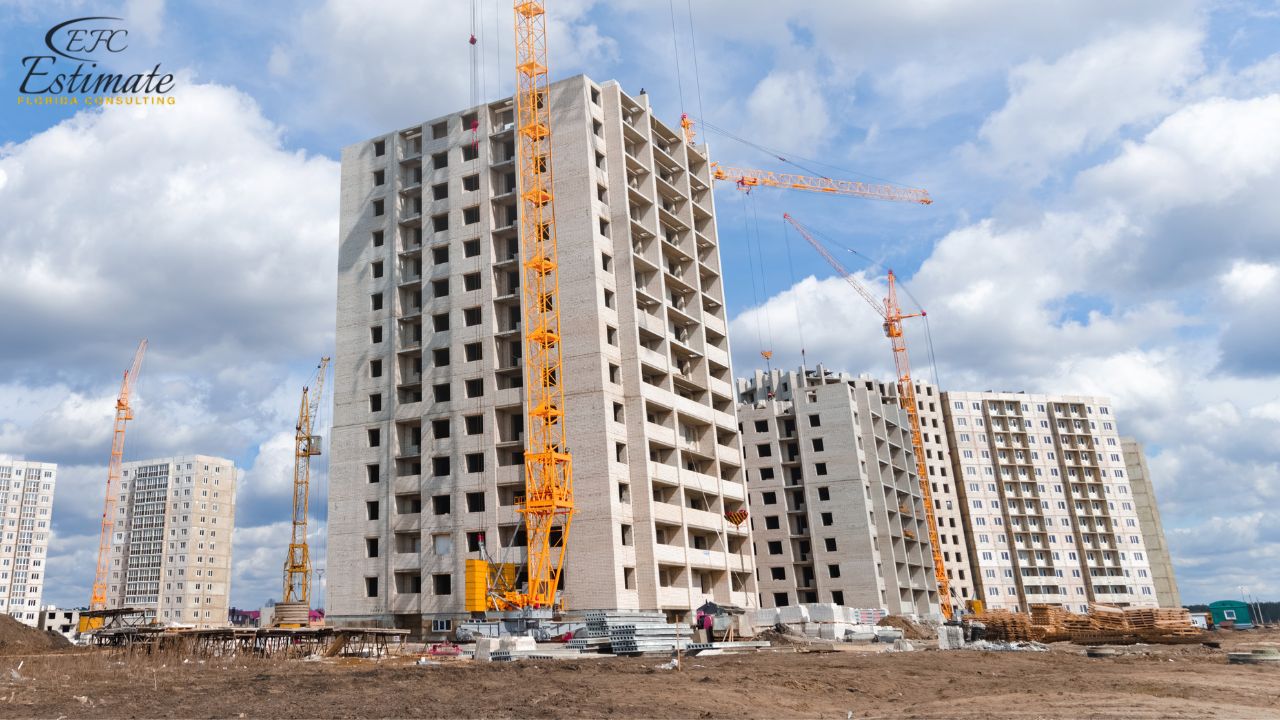
Construction Phases & Costs
Site Preparation ($200K - $2.5M):
Small complexes require clearing, grading, and basic drainage like swales ($200K – $400K) on flat, inland lots, while high-rises need extensive excavation, soil stabilization with lime or geotextiles, and advanced stormwater systems like underground vaults ($1.5M – $2.5M) due to Coral Gables’s 60+ inches of annual rain and flood risks near Biscayne Bay. Drainage uses fill at $25 – $45 per cubic yard. Coastal sites may need mangrove permits and mitigation plans ($100K – $400K). Multi-family prep includes parking lots, pedestrian walkways, and utility trenches for water and gas lines.
Foundation ($500K - $10M):
Small complexes use shallow concrete slabs with steel rebar ($500K – $1M) for 2-3 story builds on stable soil, while high-rises require deep pilings (80-120 feet at $40 – $60 per linear foot) or caissons drilled into limestone ($5M – $10M) to support multi-story loads and counter Coral Gables’s high water table and sandy conditions. Flood zones like Liberty City demand elevated bases with flood vents and waterproofing membranes for resilience.
Structure ($1M - $30M):
Small complexes use steel or concrete frames with flat, insulated metal roofs ($1M – $2M) for cost efficiency, while high-rises employ wide-span steel with reinforced concrete cores, hurricane bracing, and multi-story framing ($15M – $30M). Exterior walls feature CMUs or precast concrete panels with anti-corrosive sealants for salty air, and interiors include soundproof drywall and insulation between units. Structures meet 175 mph wind codes per Miami-Dade standards, with added roof straps for safety.
Interior Finishes ($400K - $8M):
Small complexes use vinyl plank flooring, basic fixtures, and standard cabinetry ($400K – $800K) for budget-friendly units, while high-rises add hardwood floors, modern kitchens with quartz countertops and stainless appliances, and smart home systems like keyless entry ($5M – $8M). Balconies with glass railings, noise-reducing walls, and durable finishes cater to multi-family living in Coral Gables’s humid climate.
Infrastructure ($600K - $12M):
Small complexes need efficient HVAC with split units, basic plumbing for 10-25 units, and standard electrical setups ($600K – $1.2M), while high-rises require high-capacity electrical for multiple elevators, extensive plumbing with booster pumps for upper floors, and advanced HVAC with dehumidification and air handlers ($8M – $12M). Solar film on windows and energy-efficient lighting cut cooling costs in Coral Gables’s intense heat.
Amenities ($300K - $15M):
Small complexes include courtyards with benches, in-unit laundry hookups, and 30-50 parking spaces with asphalt surfacing ($300K – $600K), while high-rises add pools with cabanas, fitness centers with cardio equipment, rooftop terraces with BBQ grills, and multi-level garages for 100+ cars with EV charging stations ($10M – $15M). Security gates, cameras, and landscaped green spaces enhance resident appeal.
Soft Costs ($300K - $6M):
Small complexes need basic permits, architectural plans with unit layouts, and utility approvals from Miami-Dade ($300K – $700K), while large projects require detailed structural engineering, zoning variances for height or density, and environmental reviews for flood or wetland impacts ($4M – $6M). Traffic studies for busy areas like Brickell and flood zone assessments add $50K – $600K.
Coral Gables-Specific Details
- Hurricane Prep: Impact windows with laminated glass, reinforced doors, and roof tie-downs with steel straps add $150K – $5M, with large buildings featuring storm-resistant backups, generators, and shutters per 185 mph gust standards (2025 codes), ensuring safety during Coral Gables’s hurricane season and protecting residents from storm surges.
- Cooling Systems: HVAC with humidity control, including multi-zone units and dehumidifiers, costs $500K – $6M, tackling Coral Gables’s 70-90% humidity and ensuring resident comfort year-round with energy-efficient systems designed for high-occupancy buildings in a subtropical climate.
- Sustainability: Energy-efficient features like rooftop solar panels, low-flow plumbing fixtures, and reflective roofing add $300K – $2M, attracting eco-minded renters, reducing utility bills, and aligning with Coral Gables’s push for greener living in urban and suburban developments.
- Timeline: Small complexes take 10-16 months with simpler designs and fewer units, high-rises 36-60+ months due to complex engineering and scale, with rain (June-November) or permitting delays in areas like Coconut Grove or South Coral Gables often extending schedules by 2-6 months due to weather or bureaucracy.
- Unit Diversity: In Coral Gables’s diverse market, multi-family buildings often mix studio (500-700 sq ft), one-bedroom (800-1,000 sq ft), and two-bedroom (1,200-1,500 sq ft) units, costing an extra $100K – $800K for flexible layouts to suit young professionals in Midtown, families in Kendall, or retirees in Aventura. Larger projects add shared spaces like coworking areas with Wi-Fi, pet-friendly zones with washing stations, or outdoor grilling stations with seating, increasing costs by $400K – $1.5M to meet varied resident needs and boost rental appeal in Coral Gables’s competitive housing market.
Example Projects
- Small: A 20,000 sq ft complex with 15 units and 40 parking spaces costs $4M – $5M (12 months).
- Large: A 250,000 sq ft high-rise with 200 units and a rooftop pool costs $80M – $100M (48 months).
3D Rendering Cost for a Multi-Family Building in Coral Gables
3D rendering costs for multi-family buildings in Coral Gables vary by scope. Basic exterior visuals range from $700 – $2,000, while detailed renders with unit interiors and amenities cost $3,000 – $12,000. Animations or VR tours can exceed $18,000. Expert rendering ensures accurate visualization.
We Provide 3D Rendering Services!
For Multi-family Buildings and Other Projects
Turnaround time is 1-2 days.
Win More Projects With Us
Coral Gables-Specific Considerations for Multi-Family Building Construction
Coral Gables’s distinctive environment introduces several factors that influence multi-family building construction planning and costs.
- Hurricane Preparedness – Multi-family buildings must incorporate reinforced concrete frameworks, impact-resistant windows and doors (e.g., PGT WinGuard), and stormproof designs to endure hurricanes, increasing construction costs by 10-20%.
- Flood Zones – Areas near waterways like the El Rio Canal or low-lying zones off Yamato Road necessitate elevated foundations, sophisticated drainage systems with retention ponds, and waterproofing measures to combat flood risks prevalent in this coastal region.
- Permitting Challenges – Coral Gables enforces rigorous zoning laws, Palm Beach County building codes, and environmental standards, such as those tied to the city’s Overlay District regulations, often lengthening project timelines and elevating expenses for multi-family developments.
- Labor Availability – The intense demand for skilled construction workers across South Florida, fueled by simultaneous luxury condo and commercial projects, can inflate labor costs and lead to scheduling delays.
Thorough planning, close coordination with local authorities like the Coral Gables Community Development Department, and strict compliance with safety and environmental regulations are critical to constructing resilient, sustainable multi-family buildings in Coral Gables.
Sustainable Multi-Family Building Construction Trends in Coral Gables
Sustainability is increasingly a driving force in Coral Gables’s multi-family building construction sector, aligning luxury living with environmental consciousness.
- Energy Efficiency – Incorporating LED lighting, rooftop solar panels, and high-efficiency HVAC systems reduces long-term operational expenses, enhancing building performance and cutting utility costs for residents.
- Green Materials – The use of recycled steel, low-VOC paints, and insulated concrete forms lessens the environmental impact while boosting structural durability and improving indoor air quality for occupants.
- Water Management – Rainwater harvesting systems, permeable landscaping designs, and water-efficient fixtures address Coral Gables’s seasonal heavy rainfall, minimizing waste and promoting sustainable water practices.
These eco-friendly features may elevate initial construction costs by 5-15%, yet they yield significant long-term savings, enhance living conditions, increase property values, and may qualify for tax incentives. This approach also supports Coral Gables’s dedication to environmental responsibility, appealing to a community that values both sustainability and upscale living.
Construction Timeline Expectations for Multi-Family Buildings in Coral Gables
Understanding timelines is vital for effective planning and budgeting of multi-family building projects in Coral Gables:
- Small Multi-Family Buildings (Up to 20,000 sq. ft.) – Typically 8-14 months, depending on design intricacy and site-specific conditions, such as proximity to wetlands or residential zones.
- Mid-Size Multi-Family Buildings (20,000-50,000 sq. ft.) – 14-24 months, accounting for permitting processes, site preparation, and requirements like enhanced drainage near areas such as the El Rio Canal.
- Large Multi-Family Buildings (>50,000 sq. ft.) – 24-36+ months, particularly for projects featuring luxury amenities, low-rise boutique designs, or hurricane-resistant reinforcements common in Coral Gables’s upscale developments.
Coral Gables-Specific Factors: Stringent zoning regulations under Palm Beach County codes, hurricane-resistant construction mandates (e.g., impact-resistant materials), flood zone mitigation near coastal or canal-adjacent sites, and high demand for skilled labor in South Florida can extend timelines by 3-6 months. Early collaboration with contractors, architects, and the Coral Gables Community Development Department ensures smoother progress and adherence to local safety and environmental standards.
90% More Chances to Win Multi-family Bids with Our Estimate
Additional Construction Details in Coral Gables
Material Choices
- Concrete: Precast or poured-in-place ($160 – $220 per cubic yard) for durability.
- Steel: Galvanized ($1,600 – $2,200 per ton) resists coastal corrosion.
- Roofing: Metal or TPO systems ($12 – $20 per sq ft) for storm and heat resistance.
Design Considerations
- Orientation: Units are thoughtfully oriented to face north, reducing heat gain from Coral Gables’s intense sunlight, which enhances energy efficiency, lowers cooling costs, and provides a more comfortable living environment for residents year-round.
- Ventilation: High-efficiency ventilation systems are installed to decrease energy consumption by 10-20%, ensuring optimal airflow, maintaining indoor air quality, and supporting a sustainable design that aligns with modern residential expectations.
- Safety: Reinforced balconies, built to withstand harsh weather, and fire-rated walls, designed to prevent fire spread, meet stringent residential building codes, offering residents enhanced security and peace of mind in a high-density urban setting.
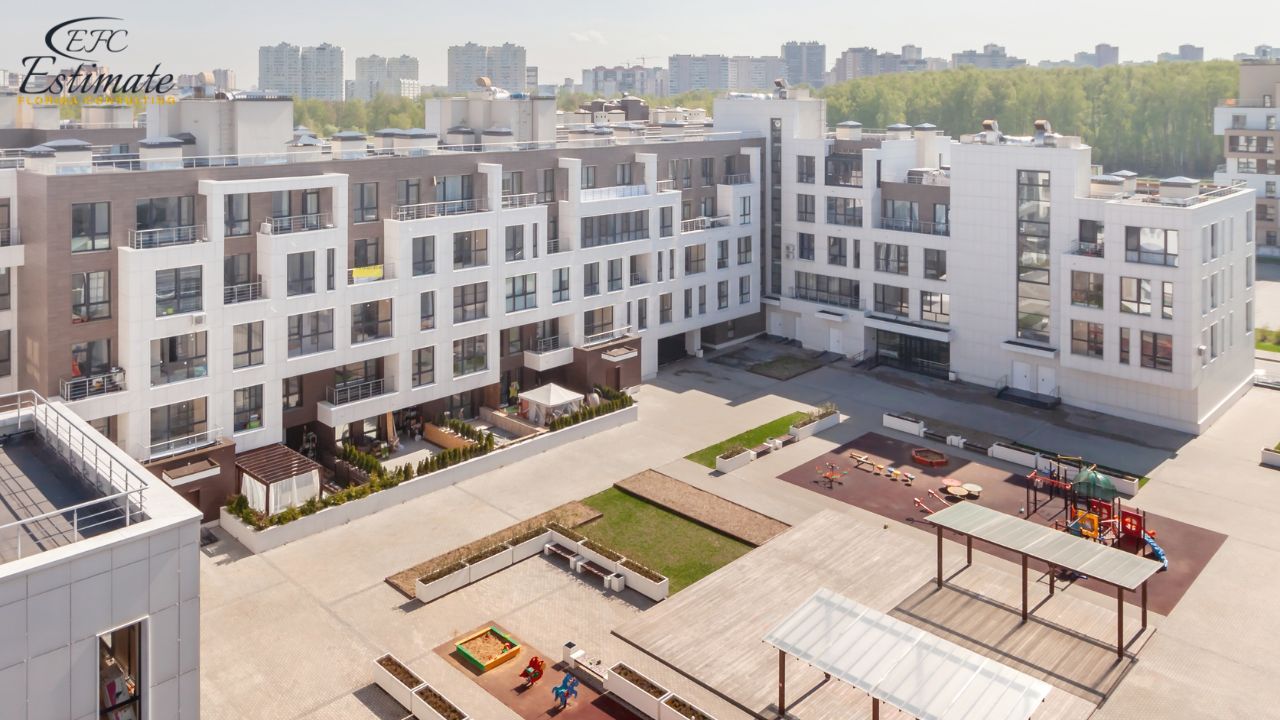
Land Acquisition Costs
- Urban Coral Gables: $100 – $300 per sq ft (e.g., $10M – $30M for 100,000 sq ft).
- Suburban Areas: $40 – $120 per sq ft, suitable for larger sites.
Contingency & Extras
- Buffer: 15-20% ($300K – $27M) for delays or material spikes (e.g., steel up 20% in 2025).
- Premium Features: Rooftop pools or smart locks add $3M – $10M.
Role of Professionals for Multi-Family Building Construction in Coral Gables
- Contractors: Oversee timelines, quality, and Coral Gables’s housing codes. Hire experienced contractors for seamless execution.
- Subcontractors: Handle plumbing, electrical, and roofing tasks. Hire skilled subcontractors for precision.
- Architects: Design functional, resident-friendly layouts meeting Coral Gables’s standards. Hire expert architects for innovative plans.
- Engineers: Ensure structural safety and system efficiency in Coral Gables’s climate. Hire top engineers for a durable build.
- Construction Estimators: Provide accurate cost assessments for materials, labor, and project timelines to help optimize budget planning and prevent cost overruns. Hire professional estimators to ensure financial efficiency and project feasibility.
Get 5 New Projects in the Next 7 Days With Our System
Why Partner with Estimate Florida Consulting?
At Estimate Florida Consulting, we master Coral Gables’s multi-family construction challenges with:
- Tailored estimates reflecting your project and Coral Gables’s market.
- Expertise in hurricane codes, zoning laws, and resident-focused trends.
- Consultations—call 561-530-2845 to begin today.
Conclusion
Multi-family building construction in Coral Gables ranges from $2M for a small complex to $135M for a high-rise tower, driven by land costs, materials, and local demands. With strategic planning, you can deliver modern, resilient housing. Contact Estimate Florida Consulting for a custom estimate and let’s shape Coral Gables’s residential future!
Question Answer
Frequently Asked Question
Multifamily construction refers to the building of residential structures designed to house multiple separate living units within one building or complex. It is typically classified into the following types based on construction methods and materials:
- Wood Frame Construction (Type V) – Common for low-rise apartments and townhouses, offering cost-effectiveness but with fire and durability considerations.
- Light Gauge Steel Construction – Used for mid-rise buildings, providing better fire resistance and structural strength than wood.
- Concrete Construction (Type I & II) – Used for high-rise multifamily buildings due to its durability, fire resistance, and noise reduction.
- Masonry Construction – Involves brick or concrete blocks, often used for mid-rise apartment buildings, offering strength and insulation benefits.
- Modular or Prefabricated Construction – Uses prebuilt sections that are assembled on-site, reducing construction time and costs.
The choice of construction type depends on factors such as budget, building height, location, and local building codes.
Type IV construction, also known as Heavy Timber (HT) Construction, is a classification defined by building codes that utilizes large, solid wood structural elements. It is known for its durability, fire resistance, and aesthetic appeal.
Key Features of Type IV Construction:
- Heavy Timber Materials – Uses solid or laminated wood beams, columns, and floors with minimum size requirements.
- Fire Resistance – The thick wooden members char on the surface when exposed to fire, slowing down burning and maintaining structural integrity.
- Minimal Use of Combustible Materials – Walls are typically made of non-combustible materials like masonry or concrete.
- Exposed Wood Aesthetic – Commonly used in industrial, commercial, and residential buildings for a natural and architectural appeal.
Common Applications:
- Historic mill buildings
- Warehouses and factories
- Modern mass timber office buildings
- Residential and mixed-use developments
Type IV construction is gaining popularity with Mass Timber Construction (MTC) techniques, such as Cross-Laminated Timber (CLT), due to sustainability and environmental benefits.
Yes, multifamily real estate is profitable due to steady rental income, economies of scale, property appreciation, and strong market demand. Investors benefit from easier financing, tax advantages, and lower vacancy risks compared to single-family properties.
However, challenges include high initial investment, management complexities, and market fluctuations. With proper planning and location selection, multifamily real estate can provide long-term financial growth.
The time it takes to build a multifamily building typically ranges from 12 months to 3 years, depending on several factors:
- Size & Complexity – Smaller, low-rise buildings may take around 12–18 months, while larger, high-rise developments can take 2–3 years or more.
- Design & Permitting – The planning phase, including architectural design and securing permits, can take several months to a year, depending on local regulations.
- Construction – The actual building process involves site preparation, foundation work, framing, utilities, and interior finishes. It can vary based on the building's size, complexity, and materials used.
- Weather & Delays – External factors such as weather conditions, labor availability, and supply chain delays can also impact the timeline.
Proper planning and experienced construction management can help streamline the process and reduce delays.
What is a Type 5 Building?
Type 5 construction refers to the least fire-resistant classification under building codes, typically using wood-frame materials for the structure. It is the most common construction type for residential buildings, including single-family homes, townhouses, and low-rise apartment buildings.
Key Features of Type 5 Construction:
- Wood Frame – The building's structural components (walls, floors, roof) are made of wood or similar combustible materials.
- Low Fire Resistance – The materials used in Type 5 construction are not as fire-resistant as those in higher construction types. However, fire-rated walls and other safety measures can still be incorporated.
- Affordable & Common – Type 5 buildings are cost-effective to build, making them popular for residential projects, particularly in low-rise buildings under 3 stories.
- Flexibility – The design can vary, from traditional wood frame houses to larger multifamily units.
Applications:
- Single-family homes
- Townhouses
- Small apartment complexes
- Some commercial buildings
Type 5 buildings are typically suited for areas with lower fire risk and where budget constraints play a key role in construction decisions.
Types of Multifamily Construction
- Wood Frame (Type V) – Common for low-rise buildings, cost-effective but less fire-resistant.
- Light Gauge Steel – Used for mid-rise buildings, offering better fire resistance than wood.
- Concrete/Masonry (Type I & II) – For high-rise buildings, durable and fire-resistant, but more expensive.
- Modular/Prefabricated – Pre-built sections assembled on-site, faster and more cost-effective.
- Cross-Laminated Timber (CLT) – Sustainable, fire-resistant wood panels used in mid- to high-rise buildings.
Each type offers unique benefits in terms of cost, fire resistance, and construction speed.
Construction Professionals For Your Project?
- Electrical
- Plumbing
- Masonry
- Roofing
- Painting
- More

